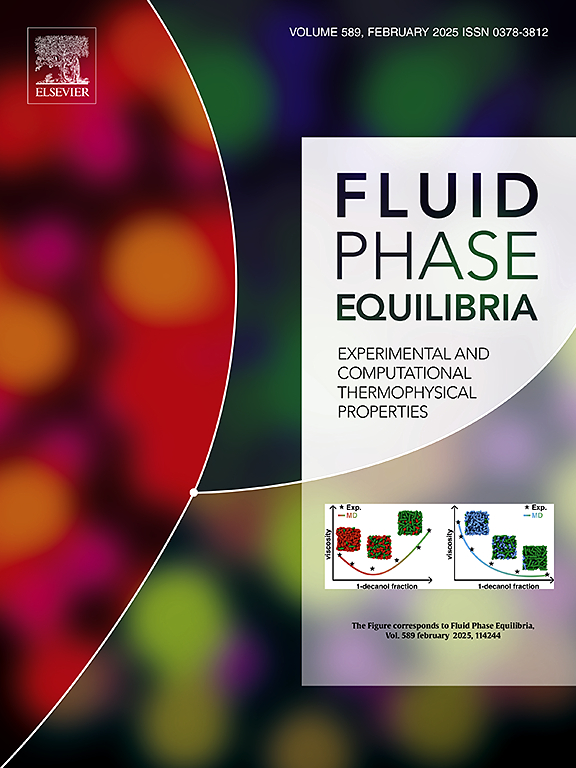Isobaric vapor-liquid equilibrium of fluorobenzene with alkyl carbonates and alcohols
IF 2.7
3区 工程技术
Q3 CHEMISTRY, PHYSICAL
引用次数: 0
Abstract
Isobaric vapor-liquid equilibrium (VLE) data was determined experimentally for binary mixtures of fluorobenzene (FB) with methanol (MeOH), ethanol (EtOH), dimethyl carbonate (DMC), ethyl methyl carbonate (EMC), and diethyl carbonate (DEC). The measurements were conducted at total pressures of 500 mbar for alcohol mixtures and 100 mbar for alkyl carbonate mixtures. The data show azeotrope formation in the alcohol and DMC systems, while EMC and DEC mixtures exhibit nearly ideal behavior. Thermodynamic consistency was evaluated using Herington, Wisniak and Fredenslund tests, with varying outcomes. The VLE data were successfully correlated using the Non-Random Two-Liquid (NRTL) model, demonstrating good agreement with experimental results. The findings contribute to a comprehensive understanding of the separation behavior of mixtures composed of these components, which is relevant for the purification of recovered solvent mixtures during lithium-ion battery recycling.
氟苯与碳酸烷基酯和醇的等压汽液平衡
实验测定了氟苯(FB)与甲醇(MeOH)、乙醇(EtOH)、碳酸二甲酯(DMC)、碳酸甲酯(EMC)和碳酸二乙酯(DEC)二元混合物的等压汽液平衡(VLE)数据。测量是在总压力为500毫巴的酒精混合物和100毫巴的烷基碳酸混合物下进行的。数据表明醇和DMC体系形成共沸物,而EMC和DEC的混合物表现出接近理想的行为。热力学一致性通过Herington, Wisniak和Fredenslund测试进行评估,结果不同。利用非随机双液(NRTL)模型成功地进行了VLE数据的相关,与实验结果吻合较好。研究结果有助于全面了解由这些组分组成的混合物的分离行为,这与锂离子电池回收过程中回收溶剂混合物的纯化有关。
本文章由计算机程序翻译,如有差异,请以英文原文为准。
求助全文
约1分钟内获得全文
求助全文
来源期刊

Fluid Phase Equilibria
工程技术-工程:化工
CiteScore
5.30
自引率
15.40%
发文量
223
审稿时长
53 days
期刊介绍:
Fluid Phase Equilibria publishes high-quality papers dealing with experimental, theoretical, and applied research related to equilibrium and transport properties of fluids, solids, and interfaces. Subjects of interest include physical/phase and chemical equilibria; equilibrium and nonequilibrium thermophysical properties; fundamental thermodynamic relations; and stability. The systems central to the journal include pure substances and mixtures of organic and inorganic materials, including polymers, biochemicals, and surfactants with sufficient characterization of composition and purity for the results to be reproduced. Alloys are of interest only when thermodynamic studies are included, purely material studies will not be considered. In all cases, authors are expected to provide physical or chemical interpretations of the results.
Experimental research can include measurements under all conditions of temperature, pressure, and composition, including critical and supercritical. Measurements are to be associated with systems and conditions of fundamental or applied interest, and may not be only a collection of routine data, such as physical property or solubility measurements at limited pressures and temperatures close to ambient, or surfactant studies focussed strictly on micellisation or micelle structure. Papers reporting common data must be accompanied by new physical insights and/or contemporary or new theory or techniques.
 求助内容:
求助内容: 应助结果提醒方式:
应助结果提醒方式:


